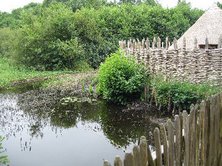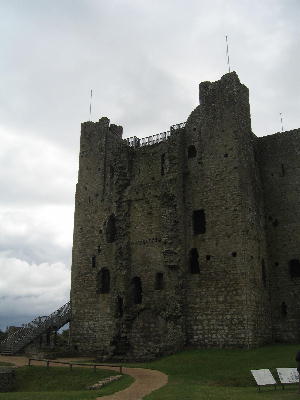I’ve always loved medieval settings, particularly anything Celtic. When “Braveheart” hit the theaters, I was mesmerized by Mel Gibson in a kilt (What’s not to like?). I was also traumatized when the heroine of the movie died within the first hour. Although it became the driving motivation for the character of William Wallace, my writer’s brain kept wondering, “What if Murrin had lived?”
It would have been a historical romance, that’s what. And like any lover of historicals, I grew up on Scottish medievals. Whether reading a time travel by Karen Marie Moning or a Jude Deveraux medieval, I scarfed them up like chocolate. When I had the chance to visit Ireland for the first time, I fell hopelessly in love with the country. I stood atop the ruins of a medieval abbey and pictured an Irish warrior rescuing his own maiden from the marauding Normans.
 That was the beginning of my Irish medieval mini-series, the MacEgan Brothers. At first, many publishers didn’t want to take a chance on medieval Ireland. Medieval Scotland, yes. But Ireland? Thankfully the editors at Harlequin Mills and Boon were more than willing to take a look. And though my sexy warriors wear trews (leggings) instead of kilts, they still wield swords and fight for their women.
That was the beginning of my Irish medieval mini-series, the MacEgan Brothers. At first, many publishers didn’t want to take a chance on medieval Ireland. Medieval Scotland, yes. But Ireland? Thankfully the editors at Harlequin Mills and Boon were more than willing to take a look. And though my sexy warriors wear trews (leggings) instead of kilts, they still wield swords and fight for their women.

There were some differences between Ireland and other medieval settings. For one, castles weren’t part of the landscape until the 12th century. Fortresses were called ringforts and the Norman invaders built ringwork structures. Usually these were based atop a hillside with a ditch or fosse, and a wooden palisade wall kept out wild animals or invaders. Eventually, as the Norman influence spread, some of the nobility began constructing wooden and then stone castles. Ironically, one of the Irish castles I visited for my research, Trim Castle, was where several “Braveheart” scenes were filmed.
 There were also artificial islands called crannogs. I visited a re-enactment village at Craggaunowen, near Shannon, Ireland, that boasted its own crannog. The structure had a long bridge leading to a ringfort surrounded by water. Inside were thatched stone huts, and the interior was much more primitive than I’d ever imagined. Even so, the wild intensity of these locations inspired a multitude of stories.
There were also artificial islands called crannogs. I visited a re-enactment village at Craggaunowen, near Shannon, Ireland, that boasted its own crannog. The structure had a long bridge leading to a ringfort surrounded by water. Inside were thatched stone huts, and the interior was much more primitive than I’d ever imagined. Even so, the wild intensity of these locations inspired a multitude of stories.
Last, one interesting bit of research led me to information on fostering. Irish parents would typically send their children to a close relative after they were weaned. The children would be raised by their uncle, cousin, or a family friend. Girls were fostered until the age of thirteen and boys were fostered until seventeen. This gave girls the opportunity to meet future husbands at a different tribe or clan, while boys could make alliances with other branches of their family. And while I’ve often dreamed of shipping my children off to a distant relative for a few years, I can’t imagine living without them for that length of time. It was a medieval custom, however, and one that provided a way for me to write an unusual secret baby plot, in The Warrior’s Touch.

Hi, Michelle–
I’ve always wondered what fostering did for family relationships. They must have been very different from those we have today.
Whom did the youngsters seek to please? To whom did they look for comfort? What did it do to their ability to be close to anyone? It must have been a very different world.
Patti
Patricia Frances Rowell
Hi, Michelle!
Was fostering done with all children? or only those of the ruling families?
I love the idea of medieval Ireland as setting for romances–I’m adding your books to my TBB list.
I would love to see a medieval set in Italy. I have read a couple of books that were set in Renaissance Italy.
I think Morag Pippin takes the cake for unusual settings, with her Blood Moon Over Bengal (1930s India) and Perfidia (1930s Berlin), both published by Dorchester. We have Morag and 20 other such authors over at Unusual Historicals. Always a fun time seeing where imagination takes us.
I’d like more in Renaissance Italy, too.
Hi Michelle!
I love hearing about your inspiration! My mom is a huge Jude Deveraux fan, I read all of her medievals when I was younger.
When will we see another MacEgan book from you? I love them, trews and all!
The Irish system of fostering was quite unique and it’s a shame many books set in that time and place don’t include something about that aspect of society.
How about Jean Auel’s books for a unique historical setting?
Loved the excerpt, Michelle! What can create more drama than to have your heroine bartered away to a man who possesses complete power over her? You know she must summon all her internal resources to fight back and create a place for herself. Great opening! I adore Ireland as well as Scotland and am so glad HH enthusiastically embraced your stories.
Carry, I’ve read both of Pippin’s Blood Moon (Bengal and also Britain) books and really enjoyed the settings. (WWII is a favorite time period and I’m also a fan of India stories–can anyone say MM Kaye?) I’ll have to check out your site.
LOL Patty I said the same thing! Those poor babies… just sent away like that.
Hi all!
I had problems with my Internet provider. Cox won’t let me connect, so I’m having to log in from work.
Patti–I’ve heard it said that children were far closer to their foster-parents than to their own flesh and blood. My impression is that they viewed their adopted parents as their own. I would think it would really hurt, as a mother, to have your own child call someone else as their mother.
Aztec lady–The sources I’ve read say that all children were fostered. It really surprised me, to say the least!
Jane–you would probably like Ammanda McCabe. She wrote one set in Venice.
Carrie–ooh, India sounds like a fabulous setting. I’ll look for Morag’s books.
Deb–I’m hoping to add my last two MacEgans in the near future. We’ll see how it goes! First, I’m doing an early medieval book (Her Warrior Slave) and then I’m doing a Victorian for a change of pace. After that, I may get back to them.
Liviania–I love Jean Auel’s Clan of the Cave Bear series. Especially the first book. Just beautiful.
Hi Julia!
All children? that’s really interesting… I wonder if their loyalties were tested, who would the fostered children choose?